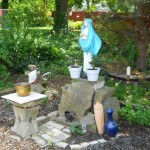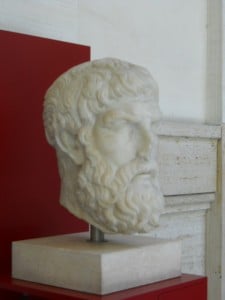Any activity you undertake can be transformed into a ritual act. By doing so, the action takes on a greater significance that integrates the conscious, external actions of the body with the unconscious, internal motivations of the soul. During repetitive activity, rhythm that makes the work easier to perform can lead one into a ritual consciousness that opens into realms of awe. Religious awe offers a loss of self-awareness that empties one into a greater whole. It is a type of consciousness that can place a worshiper in contact with her God. Ritual consciousness can thus become inspirational, creative, dynamic, and transforming. The mind, body and soul join together with a single focus, as labor is joined with ritual.
In the garden our first ritual is to orient the land onto the winds. This is performed in accordance with an ancient ritual explained by Pliny the Elder. Previously the land would have to be prepared. But before this could take place a ritual is performed to ask permission of the local spirits of the land, the genius locii. Then, calling upon celestial deities as witnesses, and on terrestrial deities to aid in your efforts, a ritual is held for the Gods of agriculture. It is during the sacrifice, before it is fully completed, that one orients the land. Using sticks and a cord, observing the stars and sun, two axes are first laid out. The cardo is the east-west axis, oriented on the rising sun of the vernal equinox of March or the autumnal equinox of September. On those same days, at midday, the north-south axis called the decumanus is determined by the shadow of a gruma that is erected at the midpoint of the cardo. Three paces are walked off in each of the cardinal directions and marked by placing a stone on the spot. Then a stretching of the cord ceremony measures out the sides of the square that one will form. That is, pulling a cord between the extreme ends of the cardo axis will give the length of the sides of a square. The four corners are then determined by stretching the cord parallel to the cardo at the northern-most and at the southern-most ends of the north-south axis. These points are likewise marked off by placing stones. This produces a plot of land roughly nine meters square. The stones will be designated as stations of individual deities and serve as the core of altars that will be built up over them. These, in effect, become palus stones into which numina are invoked during ritual. Each stone is washed and incensed in turn as a specific God or Goddess is invoked and asked to send a numen down. Then each deity receives a libation of milk and/or blood (wine can be substituted in place of blood), which is poured over the stone. The main sacrifice is then completed. The Gods called as witnesses receive offerings and our thanks before completing the ritual. This ritual is performed each year on the vernal equinox, to renew our pious dedication of the garden as the hortus Cereris.
The annual re-dedication of the garden involves an ambulation around its boundaries while bearing offerings of milk and honey, flowers, incense, and special breads and cakes. Mother Earth is invoked as Tellus Mater, as is Her daughter Ceres, and a host of minor deities who are involved in gardening. Semino (Saturn), too, is invoked as a god of the abundance and wealth of the soil. There are deities invoked for tilling the soil the first time, the second, and the third, when watering, and for when fertilizing the garden Sterculinius is invoked. The “Holy Sower,” Semo Sancus, who is celebrated on 5 June, and Sator, too, are minor gods of sowing. Sarritor is a minor god of hoeing, while Subruncinator is a minor god of weeding. And for clearing a real problem patch, Spiniensis is invoked when uprooting thorny bushes. Seia and Segetia are minor goddesses of the seeds as they lie in the earth and when they first begin to appear. The names of such minor deities refer to their specific function in aiding us at each moment in the work we do. And thus in invoking them, we call upon their presence within ourselves.
Each time the soil of the garden is turned, a ritual is performed to again place our labor into a ritual

context. The mounds turned up by tilling become little altars. Stones and pebbles taken from the soil are gathered up at the station stones previously marked out, forming these into small altars for our Gods and Goddess of horticulture. Again, when seeds are sown, weeds are pulled up, or plants are harvested the work is done within a ritual context. When sowing seeds, each is planted with a prayer to the three Goddesses of Consus. “I do this for me and my neighbors.” As another example, in early spring, after the peas first begin to sprout, trellises are strung to bear their growth. Each string you see in the picture at right is hung with its own rites. Three knots are tied above, for celestial deities, and two knots for the terrestrial deities are tied at the bottom. “The Gods above greet the Gods beneath.” Into each knot a prayer is spoken, “Gods and Goddesses, I pray that You may confer on me and mine all that is good, fortunate, and happy.” Abbreviated this becomes Quod bonam, faustum, felicemque sit for each of five knots on each string, at every two inches along three rows of forty feet each. The repetitive prayer acts as a form of chant, focusing the mind on the action. The labor of garden work, with its repetitive action, becomes a physical manifestation of that chant. The conscious mind and body preoccupied and working together frees the unconscious mind to enter into our conscious thoughts and releases the soul, focused on the Gods, into our ritual actions. The ritual context provided by the sacrifice before and after the work, along with the repetitive prayer and actions, easily leads one to a ritual consciousness of awareness.
Performing chores and labor in a ritual context is a meditative exercise. Unlike Eastern meditation that seeks to disengage the mind, and is passive both physically and mentally, pagan meditation is active. It differs, too, from the Christian form of meditation of Western civilization. Often Christian meditation involves reading passages from sacred texts or from prepared devotional texts. One is to silently ponder the meaning of these texts, applying them to himself or herself. Sometimes, as with the spiritual exercises of Ignatius of Loyola, a priest or superior directs a worshiper on what he ought to think about the passages given to him. The method used by Teresa of Avila was similar to Eastern meditation in that her “recollection” involved suppressing the intellectual mind and the senses as she focused on a prayer so that her soul might recall its spiritual origin. “Recollection” was preparatory to other stages of quiet meditation. In both Eastern and Western (Christian) meditation a goal is to disengage the mind from the body. This is due to a perspective of the physical world being somehow evil and contradictory to the spiritual world. Their either-or perspective poses that one has to reject the one side as evil, or suppress what is natural, in order to develop or to “accept” indoctrination into preconceived notions. Pagan practice instead begins with a notion of the Universe being composed of body, mind and soul, and a desire to bring these three parts into harmony. Harmony is sought within one’s own being, and also in the world around us. First, the quietism of silent prayer sharply contrasts to the practice of the Religio Romana and other pagan traditions that enjoin verbal expression, spoken aloud, with the physical actions of gesture and sacrifice. Rather than disengaging the mind, it is focused upon physical action. Roman ritual can be complex in detail, and it tends to be repetitive, acting in different ways to focus the conscious mind on those physical actions. I think that there is little doubt, too, that the ritual action and other physical aspects of Roman ritual impact on the mind and soul. This may be seen more perhaps in the ancient mysteries where ritual, leading to ritual consciousness, prepares one to enter into alternative forms of consciousness where euphoria, trance consciousness, or ecstatic consciousness may result. But the starting point begins by introducing ritual into our daily activities, developing a sound mind and a sound body in harmony with our soul, which will in turn bring us into a harmonious relationship with the Gods around us in Nature. The garden quite literally feeds our body, our mind, and our soul, even as the garden acts as a euphemism for tending our relationship with the Gods in the Universe.
Vadete in pacem Deorum.
















